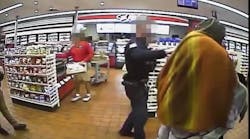The presence of cameras is widespread and increasing, from cars to smartphones, home security systems to smart cities. Video gives the viewer an unbiased, factual look at events, and for law enforcement specifically, it can increase situational awareness and actionable intelligence.
Officers cannot be everywhere at once, especially as cities feel budget cuts and manpower decreases, so many agencies are trying to augment that with technology. Cameras have become a regular tool for police departments as law enforcement officers and the communities face an ever-growing number of threats. The integration of video surveillance systems can maximize an agency’s public safety efforts.
A deterrent to violent crime
Video systems can be both a proactive and reactive tool for law enforcement. When criminals realize a town has a public safety system, they know there is a better chance of being caught and prosecuted, says Jordan Heilweil, president of sales at Total Recall Corp. “The reactive side, however, is that when there is an issue, law enforcement has a solution in place and it’s an effective tool to go back and find out the who, what, when and where.”
Placed in high-crime and remote areas, video surveillance systems can help maximize law enforcement safety efforts by giving them extra eyes. In 2016 the city of Detroit announced Project Green Light, a pilot program in which the city partnered with eight gas station owners who committed to, among other things, installing a number of high-definition (1080p) video cameras inside and outside their establishment and providing Detroit PD with real-time access to their cameras at all times. To monitor the video feeds from the partnering businesses, Detroit PD additionally established a Real Time Crime Center. One year after the initial launch, Mayor Mike Duggan announced the program had more than 100 participating locations and had helped to bring about “sustained reductions in violent crime at or near participating businesses.” According to the city, an analysis of reported crimes showed that the original eight Green Light gas stations continued to see a nearly 40 percent reduction in violent crime while newer Green Light businesses experienced a roughly 20 percent average reduction in violent crime compared to the same time period the year before.
Similarly, The New York Times reported that since surveillance technology was introduced into Chicago’s Englewood neighborhood in 2017, police say shootings were down 52 percent compared with last year. In 2017 the Chattanooga Police Department installed 15 units of a public safety video system and within three months was able to capture key evidence used to help solve a homicide.
Video evidence gives an audit trail of events that have taken place and allows response more quickly, which in turn results in a safer community. Not only do video surveillance systems maximize LE safety efforts to fight violent crime, but they can also give officers extra eyes in the field during special events, too.
Large-scale events
When it comes to large-scale events and event security, in particular, local police departments are faced with a conundrum—a large influx of people equates to a higher security risk. In order to gain more eyes in the field, law enforcement agencies are looking to high-tech, video surveillance systems to maximize public safety efforts.
Though some smaller departments might not be looking for a permanent full-time video solution, rapid deployment units can be put up for festivals and event-driven situations, and even shared between jurisdictions. As population increases for events, whether it’s a one-day concert or a seasonal tourist community, video surveillance technology can aid in law enforcement public safety and security efforts.
Agencies must also be aware that successful implementation and integration may mean public transparency. Let the public know about the technology and how it may be used before implementation. “Video surveillance used to be perceived as spying, but I explain we are not Big Brother, we are Big Mother,” says Heilweil. “We are here to assist police departments in their efforts to keep their cities safe. Many police departments use these tools in a reactive mode, meaning if something happened they then search the video. They have an audit trail of activities that provide unbiased information. The goal is to prevent crime but if it does happen, they want quick resolution.” There are plenty of positive aspects of video systems—convey them to your communities.



